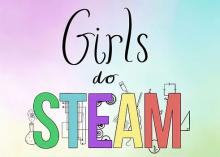Today, a mere 30% of Science, Technology, Engineering, Arts, and Math (STEAM) professionals are women who, amongst other things, are responsible for coming up with the algorithms and prototypes that will solve humanity’s biggest problems. You might have noticed that I used the term STEAM and not STEM. Although the two are extremely similar, I believe that authentic integration of the arts with STEM is important because it allows students to creatively solve problems.
If we are going to try and change this huge workforce imbalance, we need to address the psychological senses of belonging and identity that are usually the make and break factors when it comes to girls deciding whether they will pursue STEAM programs and careers. In order to build girls’ STEAM identities, we need to create positive STEAM memories. The more of us who work with girls to build positive STEAM memories, the higher the chance we can change the current situation.
Research shows that girls’ out-of-school experiences can shape their trajectory in the STEAM landscape in powerful ways. According to “Closing The STEM Gap,” a 2018 research report from Microsoft, 75% of girls who participate in hands-on STEM activities outside the classroom feel a sense of empowerment. Even well-designed media experience can have profound impact. For example, the National Science Foundation-funded TV program SciGirls helped viewers see themselves as citizen scientists. Minority girls in this study experienced an even larger impact in terms of gains in interest and self-efficacy.
If well-designed television episodes and out of school camps and clubs can impact young girls’ views of themselves, can other experiences at home with siblings, friends and parents do the same? Especially during the Covid-19 pandemic, as many of us are looking for at-home activities that foster family fun, entertainment, learning and joy, this is a critical question we need to consider.

As a high school senior for whom school-based math and science definitely did not come easy, some of my fondest memories come from a few out of the box activities in my summer camps and family outings. Being able to relate learning experiences to girls’ lived experiences is vital.
Early this year, I launched Girls Do STEAM, a community that brings together girls and women of all ages with the common goal of engagement in STEAM. Girls ages preK-6 use the Girls Do STEAM journal, I created along with a small team of fellow high school girls. The journal has the goal of inspiring girls to grow their STEAM mindsets. The community also consists of older girls and women in STEAM professions who want to encourage and support young girls in developing their STEAM mindsets.
In the Girls Do STEAM journal, I tried to create opportunities for young girls to make positive STEAM memories through the activities and reflection pages. My team is working to expand the number of girls getting involved in STEAM activities by ensuring that 100% of the proceeds of the journal go to after-school STEAM programming for underprivileged girls. My team also shares electronic versions of our journal freely with under-resourced girls’ groups. There are a multitude of amazing women that lead girls’ groups across the nation and world. It is my hope that we can partner to create positive STEAM memories for young girls.
Today, many out-of-school programs for young girls are either being cancelled or deprioritized. We need to work together and commit to organizing out-of-school STEAM experiences. At the July 2020 Girl Up Virtual Leadership Summit, where thirty thousand attendees (including myself) were inspired by speakers such as Michelle Obama, Hillary Clinton, Meghan Markle, Nadia Murad, and more, I was reminded that girls frequently do not have equitable opportunities to participate in science in school as well as at home, owing to differential treatment by their parents or guardians. During our time at home, let’s have parents, older siblings, community educators and more guide and motivate young girls to explore the STEAM in their worlds.
All girls deserve to have positive STEAM memories that will fuel them as they move forward.
